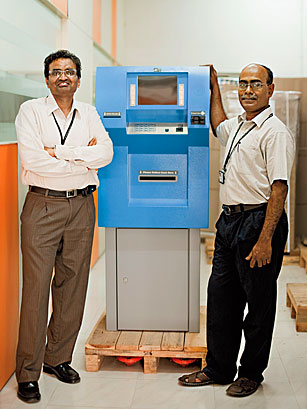
When Lakshminarayan Kannan set out to design a low-cost ATM to help deliver banking to the rural poor, he had never used one before. When he was growing up in India, ATMs were a convenience of the wealthy. "I had seen ATMs from a distance through glass doors but had not gotten near one," he says. Kannan teamed up with Vortex CEO Vijay Babu to turn his inexperience into his advantage in creating an ATM that is everything traditional ones are not: low power, low cost, low maintenance and highly robust. The Gramateller ATM was designed not to be fussy. "Our thinking was, if a person can count and issue notes by a flick of the fingers, then it shouldn't consume a lot of power," Kannan says. The machine uses about as much electricity as a 70-watt lightbulb. Backup batteries and solar panels can keep it online if the grid fails. Vortex installed a biometric touch pad to combat fraud and assure villagers new to banking that their money is safe. The Gramateller is built to dispense soiled notes without a hiccup in villages where crisp bills are often suspected of being counterfeit. The company estimates that the sales potential of the $7,000 ATMs (vs. $20,000 for conventional ones) could be as high as 40,000 a year worldwide. "Developing countries' ATM market is highly underserved," says Babu.
—by Elliot Hannon